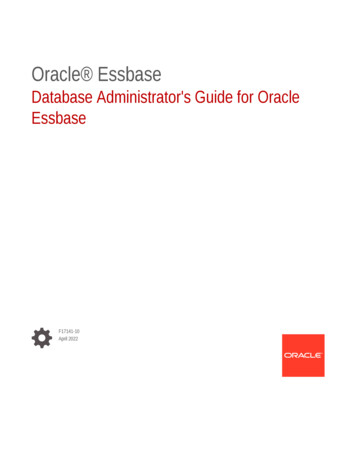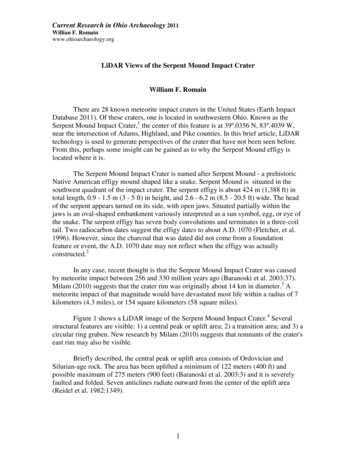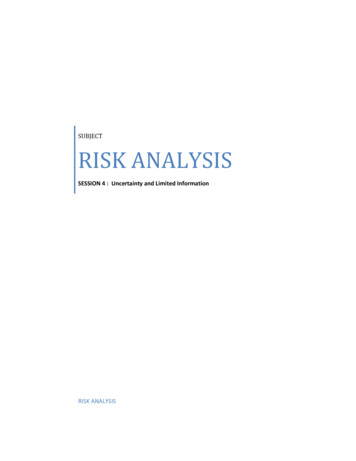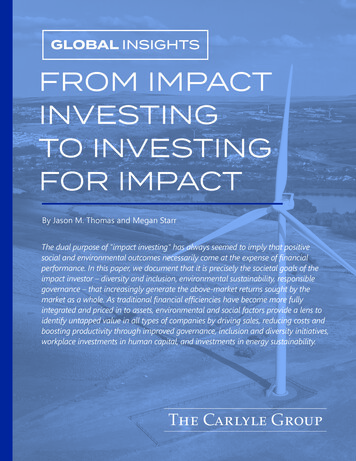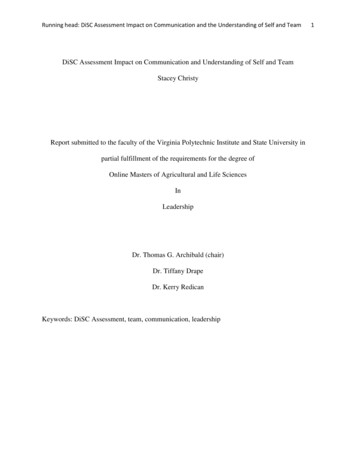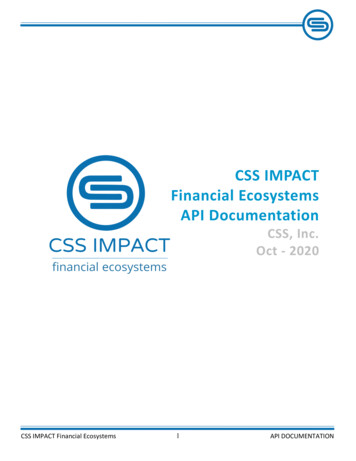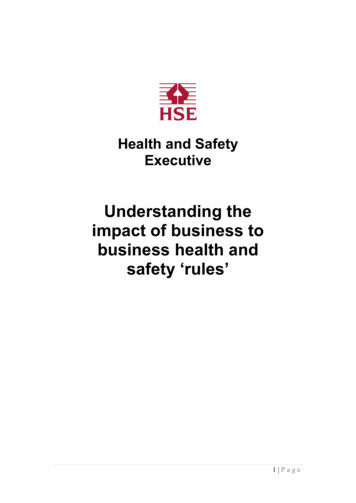
Transcription
Health and SafetyExecutiveUnderstanding theimpact of business tobusiness health andsafety ‘rules’1 Page
AbstractThis paper explores perceptions of health and safety‘rules’ and their effects both on businesses (particularlySMEs) and the health and safety system. They persistdespite significant Government attention to perceptionsof health and safety burden under its better regulationagenda.Health and safety ‘rules’ are obligations imposed not byGovernment regulation, but by businesses or businessintermediary organisations. They are variously describedby interested parties as ‘blue tape’, ‘business tobusiness burdens’, ‘private sector regulation’ and similarterms. This review will refer to them as health andsafety ‘rules’.2 Page
ContentsAbstract.2Executive summary.4Why the focus on health and safety rules? .7What we sought to explore .10Setting the context .12Key findings .14Civil law.24The role of insurers .28Managing claims .31The supply chain and external bodies’ requirements .34Management standards .38Accreditation (or conformity assessment) .443rd party advice .513rd party advice: driver and symptom? .54Some thorny cross cutting issues .61Conclusions .63Synergies with regulation.65What this all means for HSE and the health and safety system.67Annex 1 - Proportionality and effectiveness.69Annex 2 - Other potential issues .70Annex 3 - International comparison .71Annex 4 – Evidence base .723 Page
Executive summaryIntroductionHealth and safety ‘rules’ are obligations imposed by businesses or businessintermediary organisations, not by Government. This paper reviews recentHSE work exploring perceptions of them, and their effects both on businesses(particularly SMEs) and the health and safety system more widely. Theypersist despite significant Government attention given to perceptions of healthand safety burden under its better regulation agenda. Our work suggests thatfurther attention to regulation – narrowly defined as what Government does –is unlikely to offer a solution.In undertaking this work, HSE sought to develop its understanding of: The scale of the issue;How and where ‘rules’ are manifesting in ‘the system’;The key systemic drivers behind the burdens this can create;Their impact on business, and on perceptions of health and safetyburdens; andImpacts on the health and safety system as a whole.This review brings together a body of findings from a wide range of researchand stakeholder engagement conducted during 2017/18. The broader contextfor the review is HSE’s Strategy Helping Great Britain Work Well and theGovernment’s Industrial Strategy.Key findingsEvidence from the insight research (quantitative and qualitative) showed thathealth and safety burden isn’t a problem for the majority of businesses (70%),and most feel that the policies and procedures they have to have in place aresensible and proportionate relative to the risks within their business.However, a substantial proportion of SMEs do report a considerable healthand safety burden, reporting that: The policies and procedures they have to have in place are excessiveand disproportionate (39%); There is no real link between what they have to do for health andsafety and actually keeping employees safe (35%).Furthermore, 39% of businesses reported feeling that taking responsibility forhealth and safety just feels like more and more paperwork, with no obvioushealth and safety benefit.4 Page
Sources of burdensSMEs’ policies and practices are subject to a wide range of rules, whichcumulatively outrank the impact on them from regulation and enforcement.Rules arise from a number of sources: Insurers’ requirements and the wider fear of civil litigation emerged askey drivers;In procurement, the use of accreditation (or conformity assessment)schemes and verified standards such as ISO 45001 has value, buttheir use for assurance purposes needs to be proportionate andcontext-sensitive, especially when used in relation to low-risk activities;Since ‘system management’ verified standards can come across forSMEs with the force of regulation (especially where imposed throughthe supply chain), greater involvement of SME end users in theirdevelopment is important;The overall value of third-party advice to duty holders can becompromised where a segment of the market delivers advice that isneither tailored to the user nor (in some cases) even competent.Maintaining and improving standards in this area is key.In particular, for ‘directed’ SMEs operating in more complex environmentssuch as supply chains, health and safety rules play a significant role in drivingbureaucracy and other business costs that may not be adding value to healthand safety on the ground. For SMEs dealing with multiple health and safetyrules, regulation can seem “somewhat beside the point”. They also told usthat “compliance with regulation can seem insufficient”. The problems arecompounded for most SMEs because HSE is not a ‘go to’ source of advice,and “only appears as a distant regulatory body”.HSE also has concerns about some of the quality assurance controls thatsupport the use of rules. Effective deployment of/response to them requiresconcomitant governance, monitoring and audit. These provide assurance atorganisation level to ensure businesses aren’t missing risks, overestimatingcompetence or misjudging how effective operational controls are.Our research found that rule makers and those who impose them are notalways held to account for the burdens they impose, nor is the value that theymay add critically evaluated. More often than not, rules tend to be blurred with‘red tape’, and reported as such. Government is then charged with drivingimprovements, even when something other than regulation has beenidentified as the source of the problem.This skews perception of ‘regulatory’ burdens and may limit government’sability to effect change via regulatory reform. It is unlikely that HSE’s work onbetter regulation will deliver the outcomes we want to see if we can’t shiftwider practice in the health and safety system. Future debate around burdensshould include consideration of these rules. We also consider there is merit inresearch focussing on other sources of rules businesses have to follow5 Page
beyond health and safety. This will help government as a whole gain a clearpicture, both of what is really driving businesses’ practice on the ground, andperceptions of the burdens that can arise from the use of rules. It could alsohelp identify concerted action to tackle problems.What next?HSE now has a much greater understanding of what is influencing duty holderpractice, the impact of these various drivers, and their interaction with theGovernment regulatory regime. This presents us with a significant opportunityto work with and through the system to drive evidence-driven improvements totackle the key challenges – including in HSE policies and practice.Rules can lead duty holders to take positive and proportionate action onhealth and safety. We welcome this – and recognise that rules and theintermediaries behind them are essential components of the system. Wewant to work with others in the system to tackle disproportionate practiceswhere they exist, and help businesses struggling with unnecessary burdens.Businesses see a continuing role for HSE in challenging poor practices (i.e.using our voice to influence where we can) and have been supportive of HSEscrutiny in this area. Recently-published HSE guidance on navigating therules will be an important component in driving reform, and in givingbusinesses the confidence to dispense with unnecessary paperwork. We willalso continue to have a role as exemplar.However, no one organisation in the system has all the levers to influencechange, and some of the remaining issues will require joined-up action. Keywill be developing a system-wide understanding of what good/proportionateuse of rules looks like, with examples of good/bad practice. Sharing ourunderstanding of this with health and safety professionals at the ‘sharp end’ ofputting it into practice with the SMEs most affected by the current rules culturewill also be important.6 Page
Why the focus on health and safety rules?The health and safety system in Great Britain has evolved over many years.Regulators like HSE and Local Authorities are key actors in it, setting andenforcing standards that duty holders must meet. Many others also have apart to play, including: the professional bodies and their members supportingduty holders’ compliance, who can enhance performance; standard-settingand accreditation bodies; machinery, equipment and materials suppliers;contracting organisations procuring goods and services from suppliers; tradeassociations; the insurance industry; and both the criminal and civil branchesof the legal profession.HSE’s strategy for the system, Helping Great Britain Work Well1 (HBGWW),recognises that:“Successful organisations understand that sensible and proportionaterisk management is integral to delivering their business supportsgrowth, enables innovation and protects an organisation’s most vitalasset, its people.” and has as one of its aims:“ a common understanding of what proportionate health and safetylooks like.”Promoting proportionate risk management remains a corporate priority forHSE.2 It’s therefore essential that HSE understands business perceptionsabout the regulatory system and proportionality, and crucially, what is drivingthose perceptions.Slaying “the health and safety monster”‘Health and safety’ has in recent years been subject to two major reviewsaimed at tackling perceived disproportion in the regulatory system and itsimpact on health and safety outcomes.These reviews, the first conducted by Lord Young3 and the second byProfessor Ragnar Löfstedt,4 led to targeted regulatory reforms, but generallyconfirmed that the Health and Safety at Work etc. Act 1974 (HSWA), and thesupporting regulatory framework, were fit for purpose. HSWA’s outcome focussed regulatory framework was overall seen to be modern, risk–based,and generally supported by the business world. Further to these reviews the2014 Triennial Review of HSE5 noted ‘nearly universal praise and support forHSE’ and its regulatory regime.1Helping Great Britain Work Well (HSE, 2016)HSE Business Plan, 2019/203Common Sense, Common Safety, (Lord Young of Graffham PC DL, 2010)4Reclaiming Health and Safety for all: An independent review of health and safety legislation(Professor Ragnar Löfstedt, 2011)5Triennial Review Report: Health and Safety Executive (Martin Temple, 2014)27 Page
Why perceptions of burdens persistDespite these reviews and many years of reform under the better regulationagendas including the Red Tape Challenge6, research has shown that whilemost Small and Medium Enterprises (SMEs) support the spirit of health andsafety regulation (recognising its role as an enabler of growth and innovation),some continue to find a lack of proportionality burdensome in their experienceof health and safety.7Recent insight research for HSE on stakeholder perceptions of theorganisation (the ‘Audience Measures’ report)8 asked about proportionalityand the extent to which messaging in the UK health and safety system iscoherent and unified. Stakeholders, business leaders and MPs responded asfollows:Figure 1: Stakeholder views on proportionalityStakeholdersBusinessleadersMPsIn GB, healthand safetyregulation isproportionate(% agree)In GB, healthand safetyregulation isproportionate(% whostronglyagree)There is acoherent,unifiedmessageabout healthand safety inGB (% whoagree)44%59%35%30%34%49%There is acoherent,unifiedmessageabout healthand safety inGB (% whostronglyagree)20%22%45%11%Did not askMPsDid not askMPsThe relatively low figures reported under ‘strongly agree’ suggest that wehave not yet achieved the strategy aim on proportionality set out above, orcoherence in messaging about health and safety in Great Britain.However, an accumulating body of evidence suggests that the burdens citedby business are not necessarily driven by regulations, but rather by third partyfactors, i.e. health and safety ‘rules’, including the fear of civil action.Better regulation and the Industrial StrategyHSE’s strategy for the health and safety system (HGBWW) is well alignedwith the Government’s Industrial Strategy, which notes that:6Health and safety – the Red Tape Challenge (Cabinet Office web archive, 2015)SME Communications Research (HSE 2016); and BEIS Business Perception Survey (2016)8Audience measures (HSE, 2018 (publication due 2020)).78 Page
“The right business environment demands a regulatory systemresponsive to not only today’s economy but to the future economy aswell. We are committed to this aim.”“We are determined to have the right support for small businesses.Smaller businesses, without the clout of scale, can sufferdisproportionally from heavy-handed regulation and bureaucraticexcess. They can also find themselves exposed to detrimentalbehaviours – intentional or otherwise – by larger businesses that aretheir suppliers and customers.”9This work clearly demonstrates the contribution HSE can make to theIndustrial Strategy’s commitments to build“a more comprehensive evidence base on the impact of regulation”and to“ensure that the government makes the most of all its policy levers toachieve success.”109Industrial Strategy – building a Britain fit for the future (Department for Business Energy andIndustrial Strategy, 2017)10Ibid.9 Page
What we sought to exploreHGBWW and the Industrial Strategy give impetus to HSE’s work exploring inmore detail questions about how and why these burdens arise; the extent oftheir impacts; and possible actions to mitigate these.By bringing greater transparency to where and why SME burdens are arising,HSE can play a more active and targeted role in tackling them.In undertaking this work, HSE sought to develop its understanding of: The scale of the issue;How and where ‘rules’ are manifesting themselves in ‘the system’;The key systemic drivers behind the burdens this can create;Their impact on business, and on perceptions of health and safetyburdens; andTheir impact on the health and safety system as a whole.This review brings together a body of findings from a wide range of researchand stakeholder engagement: HSE insight research including: Understanding Business to BusinessBurden (2018); Audience Measures (2018); SME communicationsresearch (2016);HSE investigation of the role of third party advice through a YouGovsurvey and interviews and workshops with HSE and Local Authorityinspectors (2017);engagement with a range of business bodies including health andsafety professionals, trade associations, insurers, SMEs and largercontracting bodies, solicitors and auditors;desktop review of over 80 government, business and academicsurveys and reports; anddesktop reviews of relevant press coverage, marketing material andwebsites.In particular, this report draws heavily on HSE’s research UnderstandingBusiness to Business Burden (2018). For ease of reference throughout thisdocument it is hereafter referred to as “the insight research”.While the research considered the role of businesses and organisations of allsizes, the research into burdens arising from rules was focused on SMEs, inline with the emphasis on this category of businesses in HGBWW and theIndustrial Strategy.10 P a g e
Key themesThe evidence gathering was framed around 4 key themes: Civil law;The insurance market;The supply chain, including the role of management standards andaccreditation (or conformity assessment); andThe role of 3rd party advisers, and in particular health and safetyconsultants, including consideration of the quality of the advice in themarket.These themes are explored in detail in the key findings section.11 P a g e
Setting the contextHealth and safety lawTo set the ‘rules’ in context, it is important to first understand the basis ofBritish health and safety law: the Health and Safety at Work etc Act 1974(HSWA). The Health and Safety Executive11 and Local Authorities areresponsible for most enforcement of work-related health and safety legislationin Great Britain.HSWA clearly places responsibility on those who create risks to ‘own’ ormanage them. This applies whether the risk owner is an employer, selfemployed or a manufacturer/supplier of articles or substances for use at work.Whatever the corporate status, each risk owner must implement a range ofactions to manage them.The Act is outcome focused, not prescriptive in nature. The duty holder doesnot have to remove all risks, but must do everything ‘reasonably practicable’to protect people from harm. What the law requires here is what goodmanagement would lead employers to do anyway: that is, consider the risksand take sensible measures to reduce them. The duty holder is not requiredto remove risks where the time, trouble and effort required to do so would begrossly disproportionate.In addition to criminal law obligations as set out by HSWA, employers alsohave a duty of care under civil law. Neither HSE nor Local Authorities enforcethis. Instead, if someone has been injured or made ill through employernegligence they may be able to make a claim for compensation.HSWA and the duty of care under civil law apply across the economy.Unsurprisingly therefore, health and safety is consistently reported as one ofthe main areas of regulation that businesses, particularly small businesses,have to engage with.11HSE regulates only in Great Britain, not the entire United Kingdom. In Northern Ireland workplacehealth and safety is regulated by HSENI. Certain areas of risk or harm directly or indirectly related towork activity are covered by legislation other than the HSW Act and are not dealt with by HSE. Theseinclude consumer and food safety, marine, railway, and aviation safety and most aspects ofenvironmental protection.12 P a g e
Figure 2: Most significant types of regulation SMEs identify as mostrelevant to them12The potential for health and safety to act as both an enabler and barrier tobusiness is therefore significant.1312Regulation Returned – What small firms want from Brexit (FSB, 2017)The term ‘significant’ should be read as carrying its everyday meaning only, and not as implyingstatistical significance. Where statistical significance is inferred, we use the term ‘statisticallysignificant’.1313 P a g e
Key findingsScale of the issueEvidence from the insight research (quantitative and qualitative) showed thathealth and safety burden isn’t a problem for the majority of businesses(70%),14 and most feel that the policies and procedures they have to have inplace are sensible and proportionate relative to the risks within theirbusiness.15However, a substantial proportion of SMEs do report a considerable healthand safety burden, with other research reports into the issue citing between15% and 50% experiencing a considerable burden.16As shown in figure 317 below from our insight research, SMEs report that: The policies and procedures they have to have in place are excessiveand disproportionate (39%); There is no real link between what they have to do for health andsafety and keeping employees safe (35%).Figure 3: Disproportionate and excessive burdens18Don'tknowThe health & safety policies and practices we have to have inplace feel excessive and disproportionate relative to thehealth & safety risks present within our businessSometimes it feels like there is no real link between what wehave to do for health & safety and what we need to do to keepemployees safe at work2%3%Disagree strongly(1-3)36%37%Disagree slightly(4-5)23%25%Agree slightly(6-7)17%15%Agree strongly(8-10)22%20%NetAgree39%35%Q3. I am going to read out a number of statements about H&S. Can you give each a score between 1 and 10, where 1 means you strongly disagree with the statement and 10 means you strongly agree with the statement.Base: All Respondents (Total n 1433)Furthermore, 39% of businesses reported feeling that taking responsibility forhealth and safety just feels like more and more paperwork with no obvioushealth and safety benefit.Reports of these levels of burdens have over time understandably informed afocus on what Government can do to reduce regulatory burdens i.e. the red14There is a discrepancy between the 70% figure presented here and the results in Figure 3. The surveyquestions were not directly linked, so it is possible that businesses responded positively with regards toproportionality initially but responded differently when asked the specific questions in Figure 3.15Understanding Business to Business Burden (HSE, 2018)16See respectively BEIS Business Perception Surveys 2016 & 2018, Regulation Returned (FSB, 2017)and Understanding Business to Business Burden (HSE, 2018).17Understanding Business to Business Burden (HSE, 2018)18Ibid.14 P a g e
tape agenda. However, our work suggests this is far from being the solesource of the problem.Figure 4: Health and safety bureaucracy19Don'tknowSometimes taking responsibility for health & safety just feelslike more and more paperwork with no obvious H&S benefit1%Disagree strongly(1-3)35%Disagree slightly(4-5)24%Agree slightly(6-7)15%Agree strongly(8-10)24%NetAgree39%Q3. I am going to read out a number of statements about H&S. Can you give each a score between 1 and 10, where 1 means you strongly disagree with the statement and 10 means you strongly agree withthe statement.Base: All Respondents (Total n 1433)In particular, SMEs reported finding health and safety burdensome when whatthey were having to do (or felt they had to do) seemed simply to repeat whatthey had already done, over the top and/or lacking in any real link to keepingpeople safe.20Amongst the 30% of SMEs who agree to some extent that health and safetyplaces a big burden on their business, the main sources are the time it takes,the cost it imposes and completing the paperwork requirements of externalbodies.21The direct burden of understanding, interpreting, complying and keeping up todate with health and safety regulation is reported at 23% (cumulatively).22 Buta wide range of other sources of business burdens clearly have an influencetoo, both individually and cumulatively.Evidence from the qualitative research indicates that the direct costsassociated with health and safety tend to be accepted as part of doingbusiness. It is the opportunity cost associated with ‘lost time’ for running thebusiness that is the more significant factor.A note on directed and autonomous SMEsResearch conducted with SMEs in 201623 identified that SMEs fall into one oftwo categories: autonomous or directed. This earlier finding was borne out inthe insight research too, with evidence about the burden from rulesmanifesting differently in each category.19Understanding Business to Business Burden (HSE, 2018)Ibid.21From the quantitative analysis of burdens, it is not possible to unpick whether it is regulation or rulesthat are driving these factors. The following sections explore the qualitative evidence.22Understanding Business to Business Burden (HSE, 2018)23SME Communications Research (HSE, 2016)2015 P a g e
Autonomous SMEsAutonomous SMEs are largely independent when it comes to policies andprocedures. Accountability sits within the SME, and on the shoulders of theperson deemed responsible for health and safety within the organisation.Knowledge and expertise are highly variable depending upon the backgroundof the person responsible, as well as their inclination to engage with the topic.In addition, the approach taken within these SMEs is also highly variable,ranging from those who take it very seriously to those who are somewhatcavalier. These SMEs tend to be less confident that they are ‘getting it right’,as they are not being overseen/checked by anyone.Directed SMEsDirected SMEs are answerable to one or more external bodies when it comesto health and safety, including clients and customers (including localauthorities funding bodies). These bodies can and do make demands on theSME, and SMEs experience the need for compliance with these asmandatory.In our insight research sample, approximately 30% of businesses areautonomous and 66% directed (see figure 5 below). Both autonomous anddirected SMEs exist across all sizes and sectors.Figure 5 – Autonomous vs Directed SMEsDon'tknowMany of the health & safety policies and practices we have tohave in place are there to meet the requirements of anexternal body (e.g. Clients, Insurance Co.s, AccreditationSchemes, Trade Assns etc)3%Disagree strongly(1-3)12%18%Autonomous SMEsDisagree slightly(4-5)16%Agree slightly(6-7)Agree strongly(8-10)NetAgree66%50%Directed SMEsQ3. I am going to read out a number of statements about H&S. Can you give each a score between 1 and 10, where 1 means you strongly disagree with the statement and 10 means you strongly agree with thestatement.Base: All Respondents (Total n 1433)Directed SMES are more prevalent in Entertainment, Arts & Recreation (70%strongly agree) and Construction (60% agree strongly); they are leastprevalent in Agriculture, Forestry & Fishing (38% strongly agree),Manufacturing (41% strongly agree) and Professional, Scientific & Technical(41% strongly agree).Directed SMEs are less prevalent amongst those with 50 employees (44%strongly agree) but otherwise spread evenly across all sizes of SME.16 P a g e
Burdens by sector and size24In the insight research sample, business sectors25 (both directed andautonomous) reporting that they felt more burdened are (% agreeing stronglythat health and safety places big burden on their business): Agriculture & Forestry (29% strongly agree);Construction (27% strongly agree);Administration & Support Services (26% strongly agree);Accommodation & Food Services (25% strongly agree);Transportation & Storage (24% strongly agree);Wholesale & Retail; (25% strongly agree); andRepair of Motor Vehicles (25% strongly agree).SMEs with 5-9 employees feel more burdened than larger businesses (25%strongly agree).In addition, a proportion of businesses (39%) say that the policies andprocedures they have to have in place feel excessive and/or that there is noreal link between what they have to for H&S and what they need to do to keepemployees safe (35%).The sectors in which SMEs were more likely to feel that the policies andprocedures they had to have in place were excessive and disproportionatewere: Accommodation & Food Services (30% strongly agree);Transportation & Storage (29% strongly agree);Construction (28% strongly agree);Information & Communications (27% strongly agree);Finance & Insurance (27% strongly agree); andAdministration & Support Services (26% strongly agree).In this sample, SMEs with 5-9 employees also were more likely to feel that thepolicies and procedures they had to have in place were excessive anddisproportionate.The sectors in which SMEs were more likely to feel there was no real linkbetween what they had to do to satisfy others’ demands and what they needto do to keep employees safe were: Agriculture & Forestry (27% strongly agree);Wholesale & Retail; Repair of Motor Vehicles (27% strongly agree);Transportation & Storage (25% strongly agree); and24Understanding Business to Business Burden (HSE, 2018)Not all industry sectors in GB, or all business areas within each Standard Industry Code weresampled. The published summary report Understanding Business to Business Burden (HSE, 2018)provides detail on the research methodology.2517 P a g e
Real Estate (25% strongly agree).From the qualitative element of our insight research, it appears that the needto evidence compliance with requirements can become divorced from thereality of working practices ‘on the ground’. It is not that a focus on rulesleads to practices becoming unsafe (or if already unsafe, deterioratingfurther), but that evidencing requirements can become a somewhat separatework stream which fails to influence practice in the direction of improvementsthat may be necessary, or even urgent.Does it matter?HSE has not sought to quantify the economic impact arising from theseburdens, but it’s useful to place the headline findings in the context of theSME contribution to the UK economy:26 In 2017, total employment in SMEs was 16.1 million and the combinedannual
unified message about health and safety in GB (% who agree) There is a coherent, unified message about health and safety in GB (% who strongly agree) Stakeholders 44% 35% 34% 20% Business leaders 59% 30% 49% 22% MPs 45% 11% Did not ask MPs Did not ask MPs The relatively low figures reported under 'strongly agree' suggest that we



